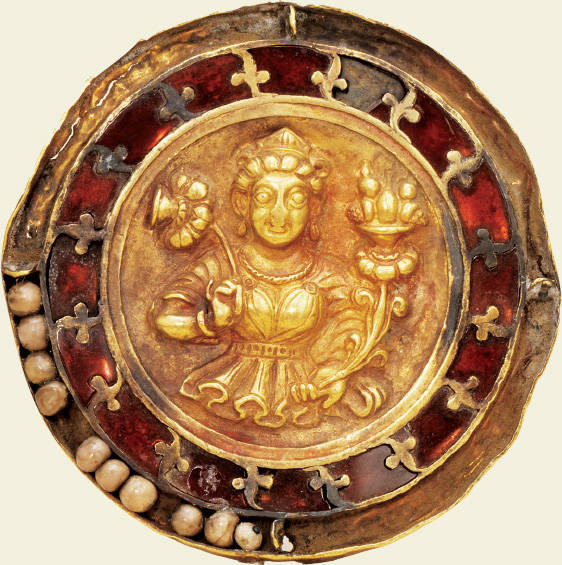Visual Source 7.4: Greek Culture, Buddhism, and the Kushans
Travelers on the Silk Roads would surely have noticed the sheer cultural variety of the people they encountered. In the bazaars of market town and caravanserais, many languages could be heard. Caravans might include merchants from various places, as the chapter-opening image shows. And the more observant of such travelers might also become aware of the mixing and blending of these cultural traditions, as reflected in the art objects and religious practices of the region.
The Kushans, a pastoral nomadic people originally from the area around Dunhuang at the far western edge of China, provide an example of this process. In the early centuries B.C.E., they had migrated to the region that now makes up northwestern India, Pakistan, Afghanistan, and Tajikistan, where they established a sizable and prosperous empire linked to the Silk Road trading network. It was a remarkably cosmopolitan place, and it flourished until the third or fourth century C.E. That empire, according to one recent account, “created stable conditions at the heart of Central Asia, allowing for the great flowering of trans-Eurasian mercantile and cultural exchange that occurred along the Silk Roads.”37
Since parts of this empire had earlier been ruled by Alexander the Great and his Greek successors (see Collision: Alexander and the Hellenistic Era), classical Mediterranean culture was a prominent element of Kushan culture. The Kushans used the Greek alphabet to write their official language, which was derived from India. The greatest of the Kushan rulers, Kanishka (ruled ca. 127–153 C.E.), styled himself “Great King, King of Kings, Son of God,” a title that had both Persian and Chinese precedents. Hindu devotional cults as well as Buddhism flourished, and the Kushan Empire became a launching pad for the spread of Buddhism into Central Asia and ultimately into China and Japan. It was here that the earliest human representations of the Buddha were sculpted, and often with distinctly Greek features. (See Visual Source 4.2.) Despite these outside influences, Kushan artists depicted their rulers in typical steppe nomadic style: on horseback, wearing loose trousers, heavy boots, and knee-length robes.
Visual Source 7.4, a Kushan pendant dating to the fourth century C.E., illustrates this cultural blending. It features Hariti, originally a fearsome Hindu goddess who abducted and killed children, feeding their flesh to her own offspring. But in an encounter with the Buddha, Hariti repented and was transformed into a compassionate protector of children. Here she is depicted holding in her right hand a lotus blossom, a prominent Buddhist symbol; her left hand holds another lotus flower supporting a flask or cornucopia overflowing with pomegranates (symbolizing food and abundance). According to local mythology, the Buddha had offered Hariti pomegranates (often said to resemble human flesh) as a substitute for the children she was devouring.

While the content of this pendant is thoroughly Indian and Buddhist, scholars believe that this representation of Hariti was probably modeled after the Greek goddess Tyche (TEE-chee), also portrayed holding a cornucopia. Furthermore, her short tunic worn with a belt was likewise of Greek or Hellenistic origin. A further cultural influence is found in the decorations that surround the image, for the border of pearls and stylized flowers derives from Persia.
Question
mlcSvQDN4lFv7WgF4YQt5vtymwZD9ufWtqKVps68FgdyO+hFMxTPNocB8INaiY8mjqPCLDRAbkL824+vFq4IjIa++cMYJUa3abrThJaf+ZOyCwv0hzj9Rqb/a0ne8Bv3C/I/5oGHkQk7aVx6sPdMyrK0b96UcCJA2G9wg3z3I8eoHv+UoHhn3g==Question
raK2kOAWDoPSYK7uwKKTId/8ygL5anzjlAPitSRV73I/QADt6LgGjCKaJU2kxLa4NBNv4GbRTw0UM9iZ//AgPyaWVI1zHjd+0GCxhUucKa/+FluLrqpczm0Ixm5aI9kw5Iv8eSn5tRTOCGSFO5fjMR5eMSU=Question
87SuHgCyFQ1XIuaXIu1LHjCnGfd1TIuUBUo9N4TH7WNgN4EO39Z3FLtlAKRkCWtCWkcQzuzgdTtpmOXUFJaznVPs06eRHgGIIHZehkj+pYdex+1ZcxPDLkEpo9Pf34vSIKt/clbPR/OdeBXiKnZgsVR9lalK8We7FIPYKApxX3uHAQBBsRdOtWXBNr71TeLpLJba0uad9V1eKSB4RrsZi1WWV/y31k395VwPOziGoUs=